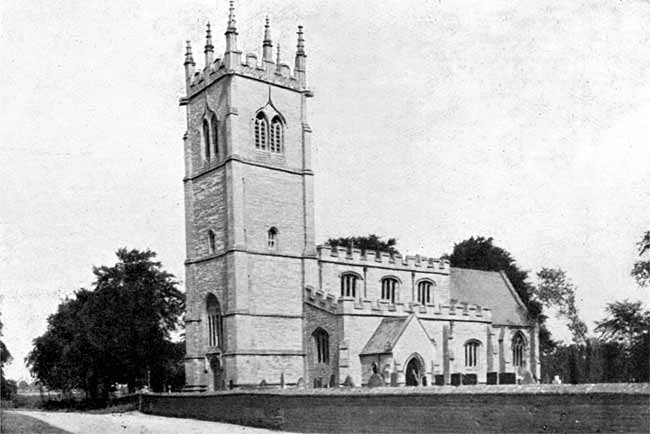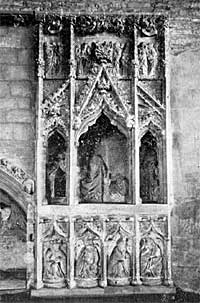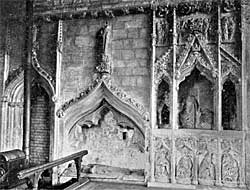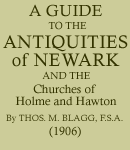< Previous | Contents | Next >
Hawton Church (All Saints).

Hawton church.
Two miles south of Newark, by a pleasant road leading past the Golf Links, the fine tower of Hawton Church is a landmark on the banks of the little river Devon. The church itself is one of the most interesting village churches in this part of the country, and would form an admirable example on which to base an object lesson in ecclesiology. Speaking generally, we may call it an Early English church, with a chancel of the Decorated period, and a tower and clearstory of the Perpendicular style. The nave arcade is all that is left of the original church, it and the aisle walls being of the thirteenth century. The pillars are plain octagonal ones, the bases showing examples of water-moulds, the capitals on the south side enriched with nail-head ornament. The hood moulding has dog-tooth ornament, and terminates with a fleur de lys, above the capitals. The chancel was built about 1320 by Sir Robert de Compton, who is buried beneath the canopied recess on its northern side. It is renowned throughout England for its beautiful Easter Sepulchre, the finest example in the world. It is probable that most churches in pre-Reformation times possessed these sepulchres, or places that were used as such, in some form or other. In many cases they were doubtless arks and tabernacles of wood, and and so were destroyed; in others an ordinary recess, such as an aumbry or locker, or the recess of the founder's tomb, was made to serve the purpose. At any rate, elaborate stone sepulchres, specially designed for the purpose are very uncommon. Nottinghamshire contains but five—Arnold, Hawton, Sibthorpe, Fledborough (fragmentary) and Laxton (doubtful); Lincolnshire has likewise five, of which Navenby and Heckington appear to be the work of the same hands as this at Hawton.

Easter sepulchre, Hawton.
Their purpose was to receive the consecrated Host, "buried" in them on Good Friday, and vigilled by a constant succession of prayerful watchers until Easter morning, when, very early, it was taken out, and in solemn state, to the singing of the anthem of Christus Resurgens, was carried to the high altar and there placed, thus symbolising the Death and Resurrection.
This Easter Sepulchre at Hawton is, as has been said, the finest example in existence, and, to the artist and the antiquary alike, is worth a pilgrimage from afar to see. The delicacy of the carving and the richness of the detail make it a perpetual feast of interest and beauty. Beneath are the Roman sentinels, asleep before the tomb; above is a canopied recess, carved with a representation of Our Lord arisen, with the Magdalen at His feet, illustrating the text, "Touch Me not." To the left is the inner recess or locker, the actual "sepulchre" in which the Holy Elements were deposited before the Easter ceremony. The background is enriched with minute diaper-work. Above the canopy of this part is represented the Ascension, the group of Apostles with upturned faces catching the last glimpse of our Saviour's feet as they disappear in a cloud heavenward, the whole flanked by angels with swinging censers. The beauty of the sculptury should especially be noticed; the draperies of that watching group, the pose of their upturned faces, have a naturalness far from the grotesque convention of most mediaeval figures.

Easter sepulchre and founder's tomb, Hawton.
Westward of the Easter Sepulchre is the tomb of the founder, Sir Robert de Compton, within an arched recess, double-cusped and richly ornamented with a crocketed head, terminating in a finial surmounted by the mutilated figure of a bishop. A hagioscope, or squint, in the walling of the recess communicated with the Chapel or Sacristy, which here abutted on the north wall of the chancel, and traces of which may be seen on the exterior of the Church. Next to the founder's tomb is the doorway to the Chapel, now walled up.
In 1330 (coinciding with the period when the chancel was built) we have an actual documentary reference to "Peter de Whitelegge, hermit of the chapel of St. Wilfrid, Houton," so that it is just possible that this was the chapel referred to. This would account for the squint, in alignment between the high altar of the church and the kneeling hermit in his cell; it is too low down to be used by a celebrating priest, though there was probably a chantry altar in the chapel also for the good of the soul of the munificent founder, Sir Robert de Compton. The whole—chapel doorway, founder's tomb, and Easter Sepulchre—are surmounted by a continuous cornice, with patrices. The Sepulchre is of Ancaster stone, and so similar to (though more beautiful than) the one at Heckington, as to be almost certainly the work of the same craftsmen.
On the south side of the chancel are the sedilia, whose richness of carving makes them a worthy vis-a-vis to the sepulchre on the north. They consist of three seats surmounted by lofty canopies and carved with many objects of interest; a pelican vulning herself, commonly called "a pelican in her piety" (in allusion to the old belief that the pelican fed her young with blood from her own breast), and a figure of St. Edmund the Martyr, holding the arrow with which he was killed at Hoxne, in Suffolk, may be mentioned. Next the sedilia is the double piscina, the unusually bold and fine finial to whose canopy should be observed.
To turn from the chancel to the body of the church, the traces of the Rood loft, showing the section of its moulding, should be noticed on the north side of the chancel arch. Some of the massive oak benches are of pre-Reformation date. At the eastern ends of the aisles will be noticed evidences of side altars: canopied niches, piscinas, &c., still remaining. Two tombs are of great interest—one the casement of the brass of Sir Robert de Compton (probably the father of the founder of the chancel) who died in 1308, lies beneath the tower; had the brass remained it would have been one of the earliest dated specimens in England. A rubbing of the casement by the writer was published by the Monumental Brass Society in 1901 (vol. II., plate 19).
The other tomb is near the north door, and bears a single-letter inscription in Lombardic capitals and the old French tongue—
"ROBERT DE GUNTHORPE GIST ICI,
DE SA ALME DEUS EVT MERCI."
A later brass of two kneeling figures, and a shield of arms, formerly affixed to the slab, have disappeared. Those interested in heraldry will notice the cross molines of Molineux much in evidence in various parts of the church.
The tower and clearstory were built by Sir Thomas Molineux, of Sefton and Hawton, who died in 1491, and whose arms, and those of his second wife, occur in the spandrels of the tower doorway. The original wooden door still remains, with fragments of its legend, "Jesu Mercy, Lady helpe," as at Balderton, and the Molineux initial.
The bells are :—
1. Founder's mark of George Oldfield (Nottingham).
Legend : " GOD SAVE HIS CHVRCH 1655."
2. Legend: "Celorum xpe placeat tibi rex sonus iste."
["O Christ, King of Heaven, may this sound please Thee!'']
3. Founder's mark of George Oldfield.
Legend: "GLORY • BEE • TO • GOD • ON HIGH • 1655." •
4. Legend: "IESUS • BE • OVR • SPEED • 1624." •
The church plate includes a chalice and paten of the Elizabethan period.
The Parish Registers, which begin in 1564, are noteworthy as containing a list of those parishioners who subscribed to the Oath of Protestation in 1641. The whole of the marriage entries in them, from the beginning down to 1812, have been printed in Phillimore's Notts. Marriage Registers, vol. IV.
